
Berchtesgaden is a municipality in the district Berchtesgadener Land, Bavaria, in southeastern Germany, near the border with Austria, 30 km (19 mi) south of Salzburg and 180 km (110 mi) southeast of Munich. It lies in the Berchtesgaden Alps. South of the town, the Berchtesgaden National Park stretches along three parallel valleys.
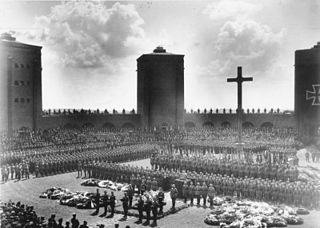
The Tannenberg Memorial was a monument to the German soldiers of the Battle of Tannenberg and the First Battle of the Masurian Lakes during World War I, as well as the medieval Battle of Tannenberg of 1410. The victorious German commander Generalfeldmarschall Paul von Hindenburg became a national hero and was later interred at the site.
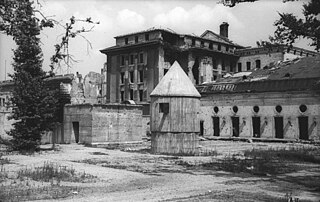
The Führerbunker was an air raid shelter located near the Reich Chancellery in Berlin, Germany. It was part of a subterranean bunker complex constructed in two phases in 1936 and 1944. It was the last of the Führer Headquarters (Führerhauptquartiere) used by Adolf Hitler during World War II.

The Berghof was Adolf Hitler's holiday home in the Obersalzberg of the Bavarian Alps near Berchtesgaden, Bavaria, Germany. Other than the Wolfsschanze, his headquarters in East Prussia for the invasion of the Soviet Union, he spent more time here than anywhere else during his time as the Führer of Nazi Germany. It was also one of the most widely known of his headquarters, which were located throughout Europe.

The Wolf's Lair was Adolf Hitler's first Eastern Front military headquarters in World War II.
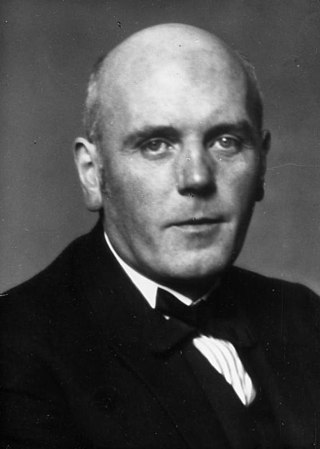
Paul Ludwig Troost was a German architect. A favourite master builder of Adolf Hitler from 1930, his Neoclassical designs for the Führerbau, the Verwaltungsbau der NSDAP and the Haus der Kunst in Munich influenced the style of Nazi architecture.

The Reich Chancellery was the traditional name of the office of the Chancellor of Germany in the period of the German Reich from 1878 to 1945. The Chancellery's seat, selected and prepared since 1875, was the former city palace of Adolf Friedrich Count von der Schulenburg (1685–1741) and later Prince Antoni Radziwiłł (1775–1833) on Wilhelmstraße in Berlin. Both the palace and a new Reich Chancellery building were seriously damaged during World War II and subsequently demolished.
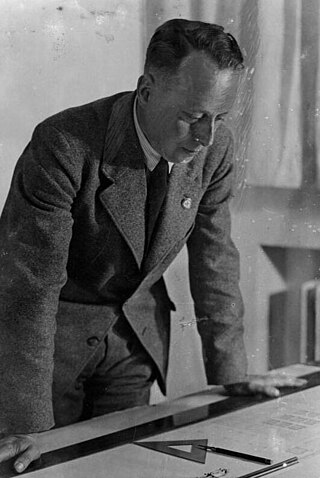
Hermann Giesler was a German architect during the Nazi era, one of the two architects most favoured and rewarded by Adolf Hitler.

Obersalzberg is a mountainside retreat situated above the market town of Berchtesgaden in Bavaria, Germany. Located about 120 kilometres (75 mi) south-east of Munich, close to the border with Austria, it is best known as the site of Adolf Hitler's former mountain residence, the Berghof, and of the mountaintop Kehlsteinhaus, popularly known in the English-speaking world as the "Eagle's Nest". All of the Nazi era buildings were demolished in the 1950s, but the relevant past of the area is the subject of the Dokumentationszentrum Obersalzberg museum, which opened in 1999.
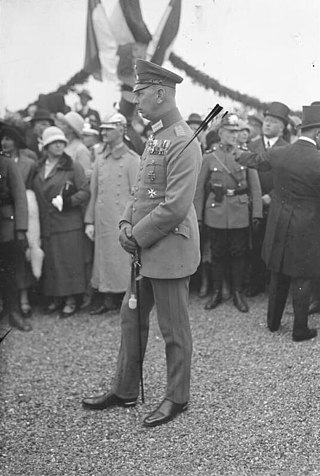
Oskar Wilhelm Robert Paul Ludwig Hellmuth von Beneckendorff und von Hindenburg was a German Generalleutnant. The son and aide-de-camp to Generalfeldmarschall and Reich President Paul von Hindenburg had considerable influence on the appointment of Adolf Hitler as German chancellor in January 1933.

Carl Fedor Eduard Herbert von Bose was head of the press division of the Vice Chancellery (Reichsvizekanzlei) in Germany under Vice Chancellor Franz von Papen. A conservative opponent of the Nazi regime, Bose was murdered during the Night of the Long Knives in the summer of 1934.
The General Walker Hotel was a hotel for US troops after World War II in the mountain (Alpine) retreat of Obersalzberg, Germany. The former Pension Moritz boarding house, boasting opulent accommodations and sweeping views of the Bavarian countryside and Alpine scenery, had been opened in 1878 and renamed Platterhof in 1928. After the Nazi seizure of power, it became a "people's" hostel for visitors to the extended containment area around Hitler's headquarters at the nearby Berghof residence. It was subsequently rebuilt into a luxury hotel for visiting dignitaries and in 1943 was converted into a military hospital.

Eva Anna Paula Hitler was a German photographer who was the longtime companion and briefly the wife of Adolf Hitler. Braun met Hitler in Munich when she was a 17-year-old assistant and model for his personal photographer, Heinrich Hoffmann. She began seeing Hitler often about two years later.
The Institute of Contemporary History in Munich was conceived in 1947 under the name Deutsches Institut für Geschichte der nationalsozialistischen Zeit. Founded by the German government and the State of Bavaria at the suggestion of the Allied Forces, it was established in 1949 and renamed in 1952. Its purpose is the analysis of contemporary German history.
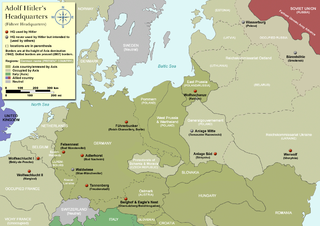
The Führer Headquarters, abbreviated FHQ, were a number of official headquarters used by the Nazi leader Adolf Hitler and various other German commanders and officials throughout Europe during World War II. The last one used, the Führerbunker in Berlin, where Hitler committed suicide on 30 April 1945, is the most widely known headquarter. Other notable headquarters are the Wolfsschanze in East Prussia, where Claus Graf von Stauffenberg in league with other conspirators attempted to assassinate Hitler on 20 July 1944, and Hitler's private home, the Berghof, at Obersalzberg near Berchtesgaden, where he frequently met with prominent foreign and domestic officials.

Adolf Hitler, dictator of Germany from 1933 to 1945, initiated World War II in Europe with the invasion of Poland in September 1939 and was central to the Holocaust. He was hated by his persecuted enemies and even by some of his own countrymen. Although attempts were made to assassinate him, none were successful. Hitler had numerous bodyguard units over the years which provided security.

Nazi architecture is the architecture promoted by Adolf Hitler and the Nazi regime from 1933 until its fall in 1945, connected with urban planning in Nazi Germany. It is characterized by three forms: a stripped neoclassicism, typified by the designs of Albert Speer; a vernacular style that drew inspiration from traditional rural architecture, especially alpine; and a utilitarian style followed for major infrastructure projects and industrial or military complexes. Nazi ideology took a pluralist attitude to architecture; however, Hitler himself believed that form follows function and wrote against "stupid imitations of the past".















